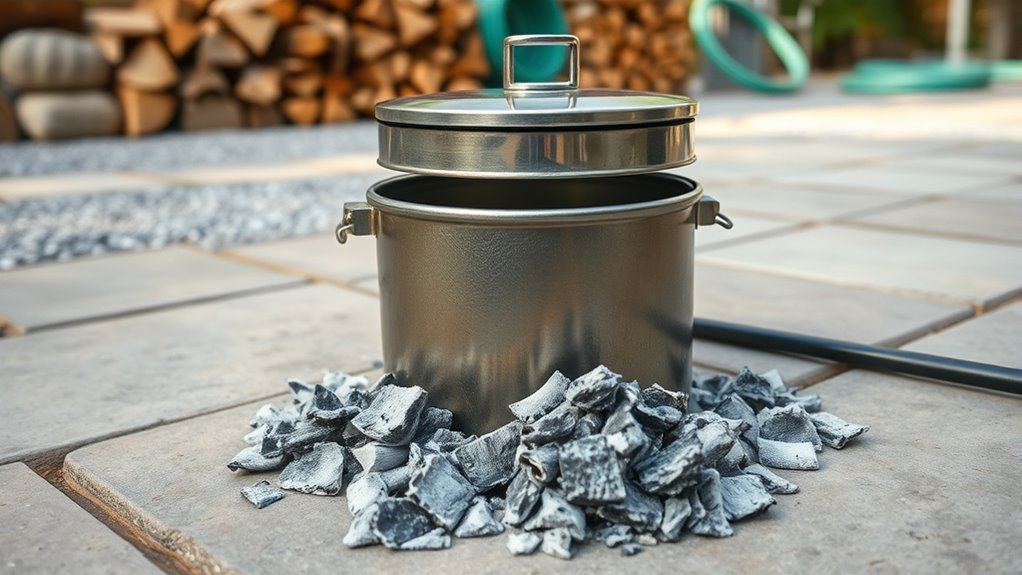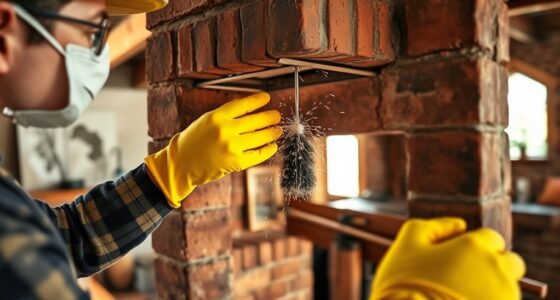To dispose of wood ash safely, first let it cool completely to prevent fires and burns. Store the cooled ash in a metal container with a tight lid, keeping it away from flammable materials. Do not dump ash into water bodies or storm drains to avoid environmental harm. Follow local regulations for disposal, and empty the container into your trash if permitted. If you’d like to learn more about proper handling and environmental precautions, keep exploring this topic.
Key Takeaways
- Allow ash to cool completely before handling and store in a sealed metal container.
- Do not dump ash into water bodies or storm drains to prevent environmental contamination.
- Check local regulations for proper disposal methods, often recommended as trash after cooling.
- Avoid using ash that contains contaminants like paint or preservatives as a soil amendment.
- Ensure ash is free of sparks or residual heat to prevent fires during disposal.

If you burn wood regularly, knowing how to dispose of the ash safely is essential. Proper disposal not only keeps your surroundings safe but also prevents potential health hazards and environmental damage. Wood ash contains various minerals and chemicals, and understanding how it reacts chemically is key to handling it responsibly. When disposed of improperly, these chemical reactions can lead to soil contamination or water pollution, impacting local ecosystems. Consequently, it’s vital to follow the right procedures to minimize the environmental impact of residual ash.
First, always let the ash cool completely before handling it. Hot ash can cause burns or ignite nearby combustible materials. Once cooled, you can store the ash in a metal container with a tight-fitting lid. This prevents accidental fires and contains any residual heat or sparks. When dealing with the ash, be aware that it contains elements like potassium, calcium, and trace amounts of heavy metals, which can influence soil chemistry if not disposed of correctly. These chemicals can react with moisture or other substances, leading to further chemical reactions that might release harmful gases or leach into the groundwater. Additionally, the chemical composition of wood ash determines whether it is suitable for use as a soil amendment or should be disposed of differently.
To dispose of wood ash safely, consider using it as a soil amendment for your garden or lawn, but only if it’s free of contaminants like paint, preservatives, or chemicals from treated wood. Wood ash can raise soil pH, making it more alkaline, which benefits certain plants but can harm others. Always test your soil before applying ash, and use it sparingly to avoid disrupting the natural balance. If you prefer not to use the ash on your property, check local regulations regarding disposal. Many communities recommend disposing of wood ash in the trash, but only after ensuring it’s fully cooled and stored properly.
Avoid dumping ash directly into storm drains, water bodies, or natural areas, as the chemicals can leach into water sources, causing environmental impact. When disposed of in landfills, make sure the ash is contained and doesn’t come into contact with moisture, which could trigger chemical reactions that produce leachate. Proper disposal minimizes the risk of environmental contamination and helps prevent the release of potentially hazardous substances into the environment. By understanding the chemical reactions involved and taking responsible steps, you protect your community and the planet from unnecessary harm.
Frequently Asked Questions
Can I Use Wood Ash in My Compost Pile?
Yes, you can use wood ash in your compost pile, but do so carefully. Wood ash acts as a soil amendment and can boost your garden fertilizer by adding potassium and calcium. Mix it in moderation, about a handful per square foot, to avoid raising pH too much. make certain the ash is completely cooled and free of chemicals, then sprinkle it evenly to enrich your compost and improve your garden soil.
How Long Should I Wait Before Disposing of Wood Ash?
Ever wonder how long you should wait before disposing of wood ash? You should wait until the ash is completely cooled, which typically takes at least 24 hours. Proper ash cooling is essential for safe disposal. Once it’s cool to the touch and no longer produces heat, you can safely handle and dispose of the ash. Don’t rush the process—waiting guarantees you avoid fire hazards and makes disposal safer.
Is Wood Ash Recyclable or Reusable in Any Way?
Yes, you can reuse wood ash as a soil amendment to improve garden fertility by adding nutrients like potassium and calcium. You can also recycle metal parts found in the ash, such as nails or hardware, through local metal recycling centers. Just guarantee the ash is completely cool and free of contaminants before reuse or recycling. This way, you reduce waste and make good use of the ash’s natural benefits.
What Are the Environmental Impacts of Improper Ash Disposal?
Improper ash disposal can lead to ash contamination and increased soil acidity, harming plants and groundwater. When you ignore proper disposal, harmful chemicals can leach into the environment, disrupting ecosystems. You should avoid dumping ashes in storm drains or on bare soil, and instead, store them in a metal container once cooled. Proper disposal minimizes these impacts, protecting soil health and preventing pollution.
Can Wood Ash Be Used as a Pest Repellent?
Think of wood ash as a natural pest control superhero in your garden. You can sprinkle it around plants to deter slugs, beetles, and other unwanted guests. Plus, it doubles as a garden soil amendment, enriching your soil with potassium and calcium. Just remember, use it sparingly—too much can harm plants. Embrace this eco-friendly trick, and your garden will thank you with healthier, pest-free growth.
Conclusion
Now that you know how to dispose of wood ash safely, remember—there’s more to take into account than just the immediate process. What hidden dangers could still be lurking if you’re not careful? A small mistake might lead to unexpected fires or environmental harm. Stay vigilant, double-check your methods, and keep safety at the forefront. Because in the end, the true importance lies in protecting yourself, your home, and the world around you—something worth every cautious step.











